advanced plant care, General Plant Care Guides, Individual Plant Care Guides, indoor plants, plant care, plant propagation, Planty People, podcast
Common Houseplant Pest Identification and How to Get Rid of Fungus Gnats, Spidermites, Scale, White Flies and Mealybugs: Grow Better with Leslie, Ep 200

As houseplant parents, most of us will inevitably encounter some type of pest infestation at some point. Seemingly overnight, our beautiful, thriving plants can become under attack by bugs we didn't even know existed! Pests can quickly damage and even kill our treasured plants if left unchecked. In Episode 2 of the Grow Better Series, my dear friend Leslie Halleck is back to teach us how to identify the most common houseplant pests and take action to get rid of them fast.
In this episode, we learn:
- [02:07] Happy 200th episode, plant friends!
- [07:29] Why experiencing plant infestations is common and not a sign of failure
- [10:16] How do your plants become infested with insects?
- [13:30] How fungal diseases and viruses spread through plants and insect vectors
- [16:58] How overwatering or misting can activate fungal spores brought in on new plants
- [17:14] What are the symptoms of a plant pest outbreak that we should regularly look for?
- [18:20] #1 Identifying fungus gnats
- [20:08] Where to find potting mixes, composts, and fertilizers for indoor and outdoor gardening?
- [22:51] Say goodbye to dark corners with Soltech’s all-new LED grow bar light.
- [24:52] How to deal with fungus gnats
- [29:40] #2 Identifying spider mites
- [31:32] What is the impact of spider mites on leaves?
- [32:05] Using a handheld microscope for insect identification
- [33:14] Why do you need to choose the right insecticide?
- [39:47] #3 Identifying roly poly bugs (note: don’t confuse with garden roly polies!)
- [40:43] How to combat mealybug infestations
- [42:56] What are the different organic control methods to manage mealybugs?
- [44:07] What is systemic pesticide?
- [45:31] Other eco-friendly alternatives
- [47:22] #4 Identifying scale insects
- [48:09] How scales manifest and why they are difficult to manage
- [50:11] How to deal with scale manifestations
- [53:12] #5 Identifying thrips
- [57:01] How to identify thrips damage
- [58:42] #6 Identifying aphids
- [58:57] How to get rid of aphids
- [01:01:13] #7 Identifying whiteflies
- [01:03:05] Why you should have a first-aid kit for plants
- [01:04:10] Homemade pest control remedies
- [01:07:14] When is a plant past the point of no return with pest outbreak?
- [01:09:18] Can you propagate a plant under pest attack?
- [01:13:00] Where can you find Leslie on social media?
Order my book!
Growing Joy: The Plant Lover's Guide to Cultivating Happiness (and Plants) by Maria Failla, Illustrated by Samantha Leung
Don't forget to subscribe to the podcast,
so you don't miss the amazing episodes we have coming up!
Why Plants Get Pests
There are a few key reasons even the best cared-for houseplants can become susceptible to pests:
Hitchhikers – Eggs or larvae can travel in on new plants, in soil, or on leaves. Carefully inspect new plants before bringing them home.
Stress – When plants are struggling from underwatering, overwatering, or improper lighting, they become more vulnerable to attack.
Environment – Certain temperatures, humidity levels, or stagnant air can create an ideal environment for bugs to multiply. Know which pests are attracted to which conditions.
Here are 7 Common Houseplant Pests and How to Get Rid of Them
How to get rid of fungus gnats in my plants
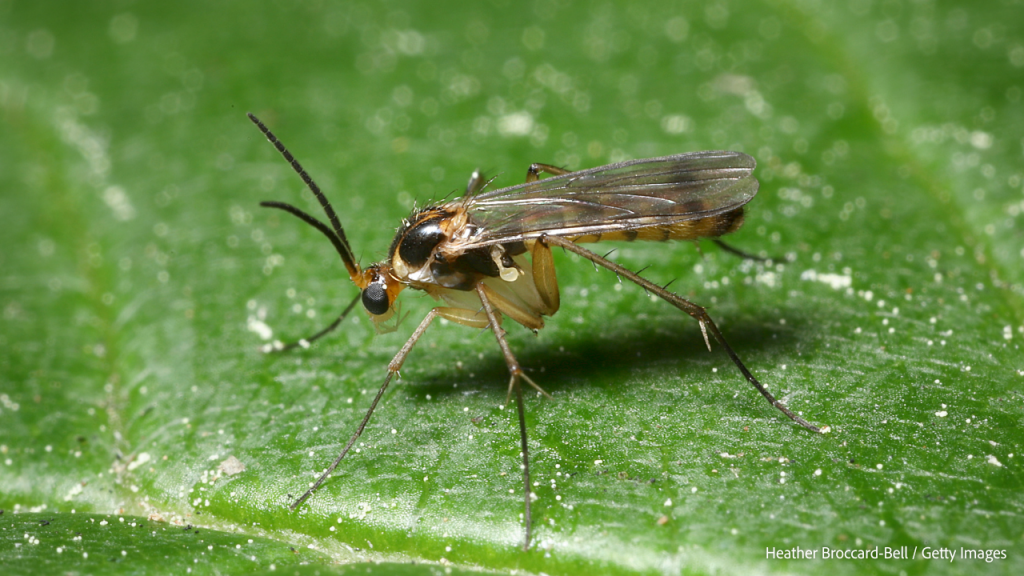
You’ll quickly notice the adults of this fly species by their erratic flying around plants! But the real culprits are the larvae in the soil, which feed on roots and cause stunted growth.
Signs to look for with a fungus gnat infestation: Adults flying around, overall decline in plant health
Getting rid of fungus gnats in houseplants:
- Use yellow sticky traps around plants to catch adults. This controls the population.
- Do a soil drench with a diluted hydrogen peroxide solution (1 part hydrogen peroxide to 10 parts water) to kill larvae.
- Allow soil to dry out more between waterings to deter larvae.
- Use BT or Mosquito Bits when you water your plants
How to get rid of spider mites on indoor plants

These tiny arachnids look like moving dots to the naked eye. Left unchecked, they form colonies and lay webbing on plants, sucking nutrients via needle-like mouths. They thrive in hot, dry environments.
Signs to look for with a spider mite infestation: Webbing on stems, yellow stippling on leaves
Getting rid of spider mites in houseplants:
- Mist plants often (moisture deters spider mites)
- Apply insecticidal soap or horticultural oil, be sure it’s labeled for mites
- Reapply the insecticidal soap or horticultural oil every 7-10 days until all the mites are gone
How to get rid of scale on my plants
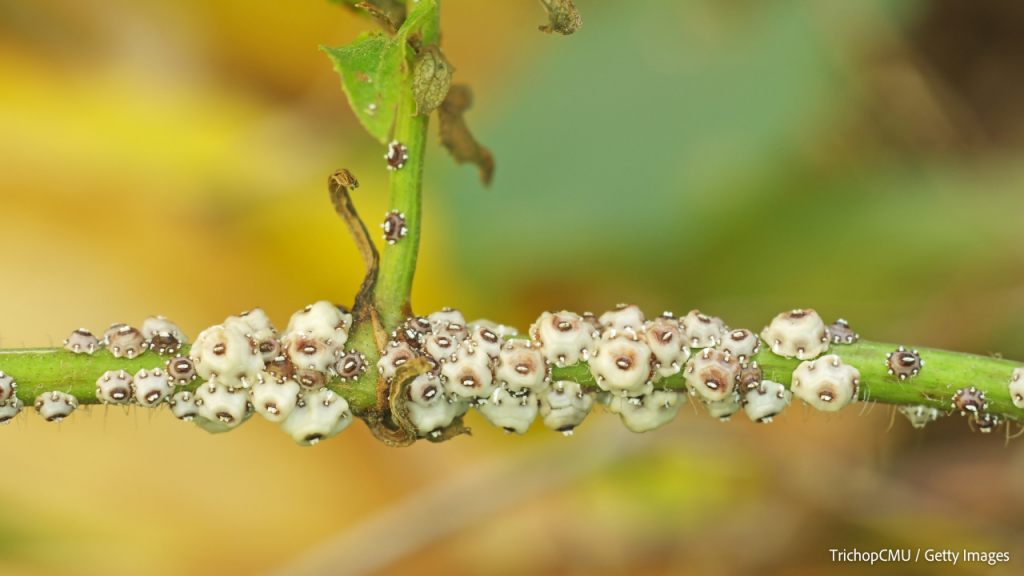
Scale insects encase themselves in a waxy, armored coating that makes them very hard to get rid of. They attach themselves to stems, leaves, and branches to feed and leave sticky honeydew in their trail.
Signs to look for with a scale infestation: Honeydew and sooty mold on leaves, leaf drop, brown “scabs” on leaves (those are the bugs)
How to control scale:
- Rub off scales with gloves and a cotton swab dipped in alcohol
- Use neem oil or horticultural oil to smother scales
- For severe infestations, apply a systemic insecticide that targets scale
How to get rid of mealybugs on houseplants
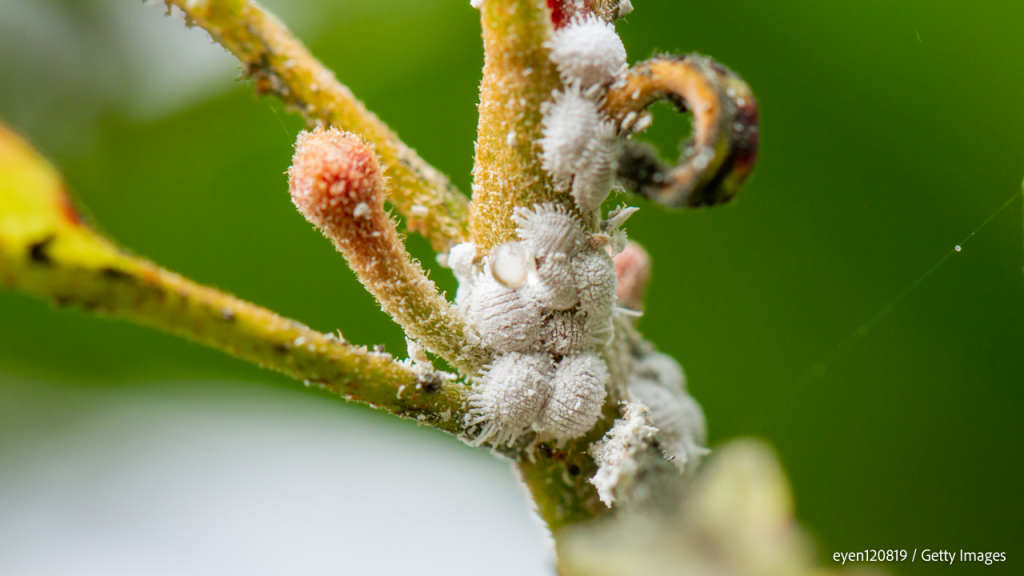
Mealybugs are soft-bodied pests that look like little cotton swabs crawling on stems and leaves. Maria called them ‘roly polys’. They produce a fuzzy white wax coating for protection. They thrive in greenhouse conditions.
Signs to look for with a mealybug infestation: White cottony tufts in leaf axils, yellowing/curling leaves, white little cotton like specs on your leaves
How to control mealybugs:
- Remove bugs with a cotton swab dipped in alcohol
- Apply horticultural oils or insecticidal soaps
- Remove heavily infested leaves and dispose of properly
How to get rid of aphids
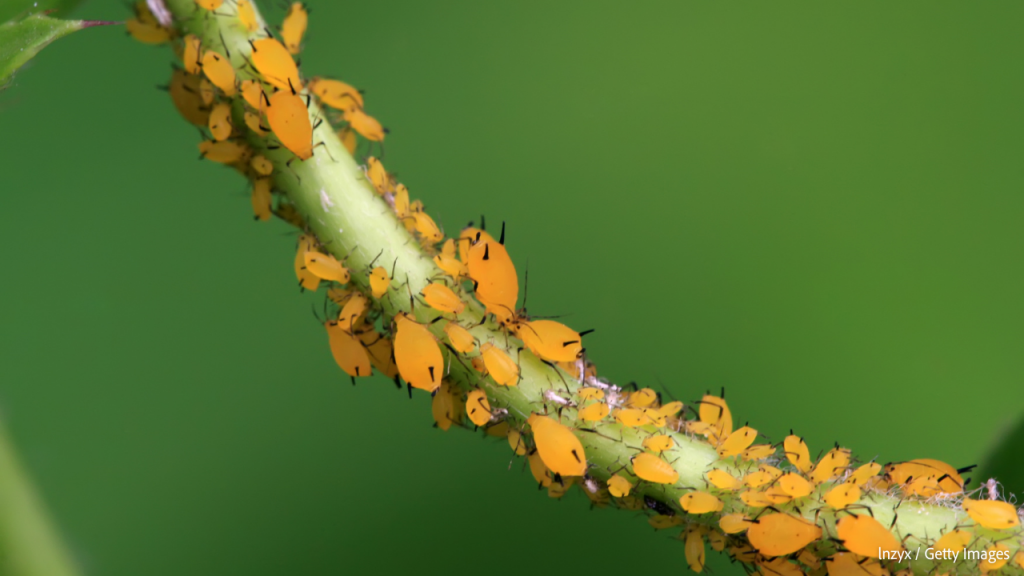
Aphids are soft-bodied insects that come in a variety of colors like green, yellow, black, or white. They feed in dense groups on stems and leaf undersides.
Signs to look for with an aphid infestation: Curled, stunted leaves, honeydew residue, swarms of the bugs on your plants – they are easy to spot
Getting rid of them:
- Blast plants with water to knock off adults
- Apply insecticidal soap to suffocate them
- Remove badly infested leaves and isolate plant
- Use neem oil or horticultural oils
How to get rid of thrips indoors
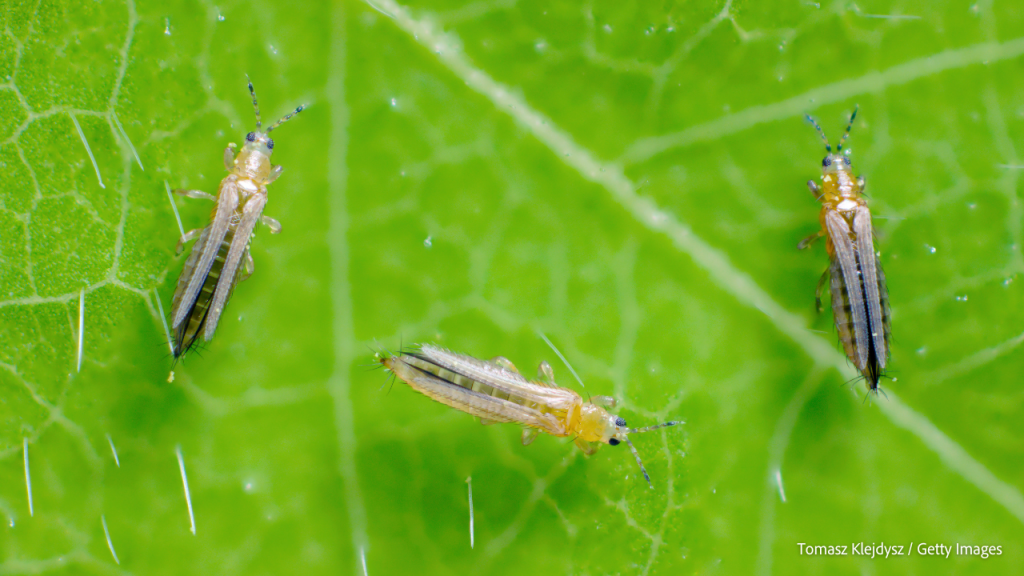
Thrips are tiny, slender insects that love feeding on leaves. They move quickly and hide in tight spots.
Signs to look for with a thrip infestation: Discolored, curled leaves, buds failing to open
How to control thrips:
- Remove heavily damaged leaves
- Apply insecticidal soap or horticultural oil
- Use sticky traps to catch adults
- Try beneficial nematodes or predatory mites
- Some biopesticides are effective
How to get rid of whiteflies on plants
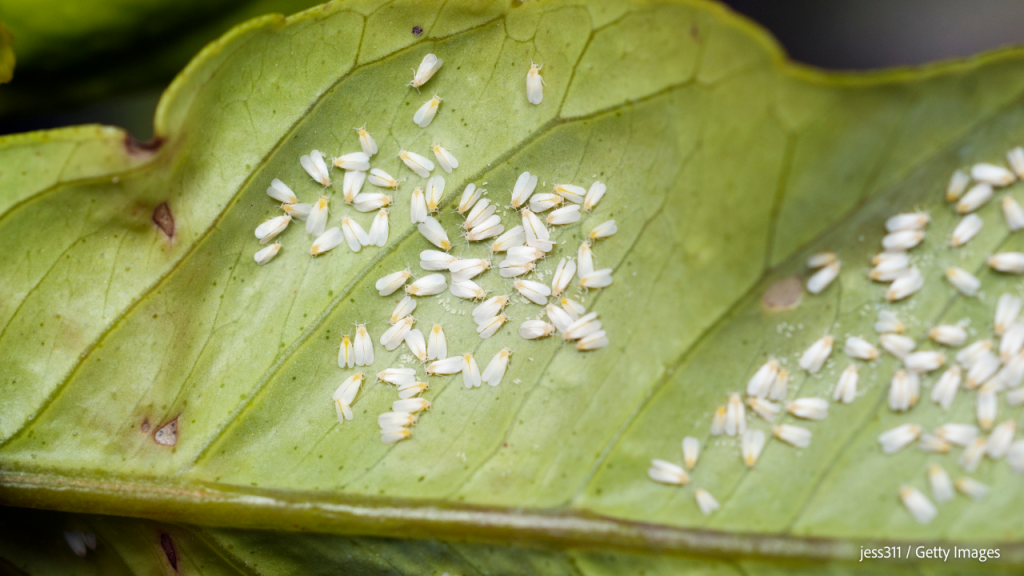
As their name suggests, these flying pests are small and white. They gather on leaf undersides and quickly reproduce.
Signs to look for with a whitefly infestation: Clouds of white flies flying around your plants when disturbed, honeydew, yellow stippling
How to control whiteflies:
- Use yellow sticky traps for monitoring and trapping
- Knock adults off with a strong water spray
- Apply insecticidal soap or horticultural oil for suffocation
- Hang up yellow plastic sheets as traps
When to Throw Away a Plant
Don’t feel guilty if a plant is beyond saving. An infestation allowed to persist can quickly take over a collection. When damage is too extensive or a plant no longer brings you joy, it’s okay to compost it and start fresh.
Building a Plant First Aid Kit
To be proactive in managing pest outbreaks, Leslie recommends assembling a plant first aid kit. The must-have items include sticky traps for early pest detection, a magnifying glass for precise pest identification, commercial or homemade insecticidal soap, and horticultural oil for effective pest control.
With some knowledge of their signs, habits, and solutions, you can catch most infestations early and get rid of houseplant pests for good. Your plant babies will thank you!
Mentioned in our conversation:
Thank you to our episode sponsors:
Espoma Organic
Ensure a thriving plant paradise with the right products! Espoma Organic is dedicated to making safe indoor and outdoor gardening products for people, pets, and the planet. They have an amazing variety of high-quality, organic potting mixes, garden soil, fertilizers, and pest control products that are organic and eco-friendly. To top it all off, they have a huge sustainability commitment with a 100% solar powered plant, zero waste manufacturing and eco-friendly packaging.
Visit espoma.com to find your local Espoma dealer or check my Amazon storefront.
Soltech Solutions
Bring the beauty of nature into your home. Soltech Solutions makes the grow lights you’ve heard me talk about for years: whether you are looking for a pendant light, track lighting, or a simple bulb to screw into any standard light fixture, Soltech has got you covered. They offer quality products with great customer service, free shipping, and a 5-year warranty. Keep the sun shining and the plants green inside your home with Soltech Solutions.
Check them out at soltechsolutions.com and get 15% off with code “bloom15”.
Follow Leslie:
Website
Instagram
Facebook
YouTube
Twitter
Follow Maria and Growing Joy:
Order my book: Growing Joy: The Plant Lover's Guide to Cultivating Happiness (and Plants) by Maria Failla, Illustrated by Samantha Leung
Join the Bloom and Grow Garden Party Community Platform & App AKA the plantiest and kindest corner of the internet! Get your FREE 2-week trial here!
Take the Plant Parent Personality Quiz (Get the perfect plants, projects and educational resources for YOUR Lifestyle)
Support Bloom and Grow Radio by becoming a Plant Friend on Patreon!
Instagram: @growingjoywithmaria
Tiktok: @growingjoywithmaria
Subscribe to the Growing Joy Youtube channel! /growingjoywithmaria
Website: www.growingjoywithmaria.com
Pinterest: @growingjoywithmaria
Buy the products we talked about!
Here are links to the houseplant first aid kit items Maria and Leslie discussed in this episode:
Sticky Traps
Option 1: https://amzn.to/3saVVj9
Option 2: https://amzn.to/3QAx0Qi
Option 3: https://amzn.to/3DLN7mC
Magnifying Glass with Light: https://amzn.to/47mxZtj
Horticulture Spray
Neem Oil: https://amzn.to/3OPlRtG
Houseplant Systemic Insecticide:https://amzn.to/3OO32a6
White Cotton Gloves for Removing Scale: https://amzn.to/3OtKf2L
Latex Gloves: https://amzn.to/47rED1G
Leave a Reply
You must be logged in to post a comment.
Stop wasting money on plants that don’t fit with your lifestyle.
Take the Plant Parent Personality™ quiz, and get curated recommendations for plants, projects, and podcast episodes inspired by your lifestyle to unlock your Plant Parent Potential!
